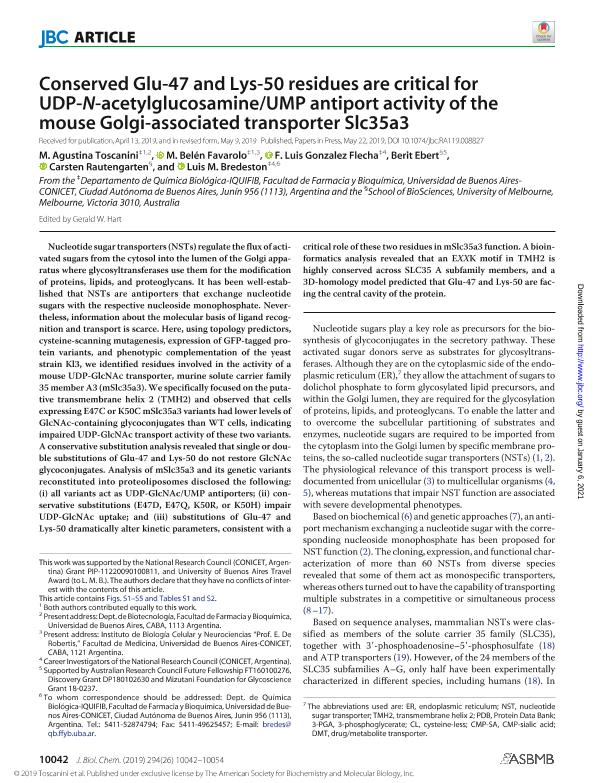Mostrar el registro sencillo del ítem
dc.contributor.author
Toscanini, María Agustina

dc.contributor.author
Favarolo, Maria Belen

dc.contributor.author
Gonzalez Flecha, Francisco Luis

dc.contributor.author
Ebert, Berit
dc.contributor.author
Rautengarten, Carsten
dc.contributor.author
Bredeston, Luis María

dc.date.available
2021-01-06T13:27:35Z
dc.date.issued
2019-05
dc.identifier.citation
Toscanini, María Agustina; Favarolo, Maria Belen; Gonzalez Flecha, Francisco Luis; Ebert, Berit; Rautengarten, Carsten; et al.; Conserved Glu-47 and Lys-50 residues are critical for UDP-N-acetylglucosamine/UMP antiport activity of the mouse Golgi-associated transporter Slc35a3; American Society for Biochemistry and Molecular Biology; Journal of Biological Chemistry (online); 294; 26; 5-2019; 10042-10054
dc.identifier.issn
0021-9258
dc.identifier.uri
http://hdl.handle.net/11336/121581
dc.description.abstract
Nucleotide sugar transporters (NSTs) regulate the flux of activated sugars from the cytosol into the lumen of the Golgi apparatus where glycosyltransferases use them for the modification of proteins, lipids, and proteoglycans. It has been well established that NSTs are antiporters that exchange nucleotide sugars with the respective nucleoside monophosphate. Nevertheless, information about the molecular basis of ligand recognition and transport is scarce. Here, using topology predictors, cysteine-scanning mutagenesis, expression of GFP-tagged protein variants, and phenotypic complementation of the yeast strain Kl3, we identified residues involved in the activity of a mouse UDP-GlcNAc transporter, murine solute carrier family 35 member A3 (mSLC35A3). We specifically focused on the putative transmembrane helix 2 (TMH2) and observed that cells expressing E47C or K50C SLC35A3 variants had lower levels of GlcNAc-containing glycoconjugates than WT cells, indicating impaired UDP-GlcNAc transport activity of these two variants. A conservative substitution analysis revealed that single or double substitutions of Glu-47 and Lys-50 does not restore GlcNAc glycoconjugates. Analysis of mSLC35A3 and its genetic variants reconstituted into proteoliposomes disclosed that i) all variants act as UDP-GlcNAc/UMP antiporters; ii) conservative substitutions (E47D, E47Q, K50R or K50H) impair UDP-GlcNAc uptake; and iii) substitutions of Glu-47 and Lys-50 dramatically alter kinetic parameters, consistent with a critical role of these two residues in mSLC35A3 function. A bioinformatics analysis revealed that a EXXK motif in TMH2 is highly conserved across SLC35 A subfamily members, and a 3D-homology model predicted that Glu-47 and Lys-50 are facing the central cavity of the protein
dc.format
application/pdf
dc.language.iso
eng
dc.publisher
American Society for Biochemistry and Molecular Biology

dc.rights
info:eu-repo/semantics/openAccess
dc.rights.uri
https://creativecommons.org/licenses/by-nc-sa/2.5/ar/
dc.subject
GOLGI
dc.subject
UDP-GlcNAc METABOLISM
dc.subject
ANTIPORTER
dc.subject
CONGENITAL GLYCOSYLATION DISORDER
dc.subject.classification
Bioquímica y Biología Molecular

dc.subject.classification
Ciencias Biológicas

dc.subject.classification
CIENCIAS NATURALES Y EXACTAS

dc.title
Conserved Glu-47 and Lys-50 residues are critical for UDP-N-acetylglucosamine/UMP antiport activity of the mouse Golgi-associated transporter Slc35a3
dc.type
info:eu-repo/semantics/article
dc.type
info:ar-repo/semantics/artículo
dc.type
info:eu-repo/semantics/publishedVersion
dc.date.updated
2020-12-01T16:25:01Z
dc.identifier.eissn
1083-351X
dc.journal.volume
294
dc.journal.number
26
dc.journal.pagination
10042-10054
dc.journal.pais
Estados Unidos

dc.description.fil
Fil: Toscanini, María Agustina. Consejo Nacional de Investigaciones Científicas y Técnicas. Oficina de Coordinación Administrativa Houssay. Instituto de Química y Físico-Química Biológicas "Prof. Alejandro C. Paladini". Universidad de Buenos Aires. Facultad de Farmacia y Bioquímica. Instituto de Química y Físico-Química Biológicas; Argentina. Consejo Nacional de Investigaciones Científicas y Técnicas. Oficina de Coordinación Administrativa Houssay. Instituto de Nanobiotecnología. Universidad de Buenos Aires. Facultad de Farmacia y Bioquímica. Instituto de Nanobiotecnología; Argentina
dc.description.fil
Fil: Favarolo, Maria Belen. Consejo Nacional de Investigaciones Científicas y Técnicas. Oficina de Coordinación Administrativa Houssay. Instituto de Química y Físico-Química Biológicas "Prof. Alejandro C. Paladini". Universidad de Buenos Aires. Facultad de Farmacia y Bioquímica. Instituto de Química y Físico-Química Biológicas; Argentina
dc.description.fil
Fil: Gonzalez Flecha, Francisco Luis. Consejo Nacional de Investigaciones Científicas y Técnicas. Oficina de Coordinación Administrativa Houssay. Instituto de Química y Físico-Química Biológicas "Prof. Alejandro C. Paladini". Universidad de Buenos Aires. Facultad de Farmacia y Bioquímica. Instituto de Química y Físico-Química Biológicas; Argentina
dc.description.fil
Fil: Ebert, Berit. University of Melbourne; Australia
dc.description.fil
Fil: Rautengarten, Carsten. University of Melbourne; Australia
dc.description.fil
Fil: Bredeston, Luis María. Consejo Nacional de Investigaciones Científicas y Técnicas. Oficina de Coordinación Administrativa Houssay. Instituto de Química y Físico-Química Biológicas "Prof. Alejandro C. Paladini". Universidad de Buenos Aires. Facultad de Farmacia y Bioquímica. Instituto de Química y Físico-Química Biológicas; Argentina
dc.journal.title
Journal of Biological Chemistry (online)

dc.relation.alternativeid
info:eu-repo/semantics/altIdentifier/url/http://www.jbc.org/lookup/doi/10.1074/jbc.RA119.008827
dc.relation.alternativeid
info:eu-repo/semantics/altIdentifier/doi/http://dx.doi.org/10.1074/jbc.RA119.008827
Archivos asociados
